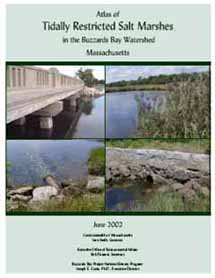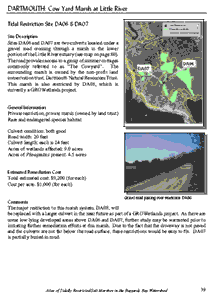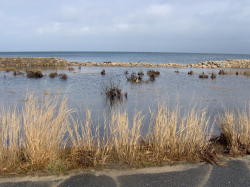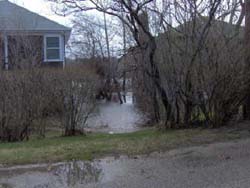The Atlas of Salt Marsh Tidal Restrictions in Buzzards Bay
Related Pages: Tidal Datums | Salt Marsh Expansion with SLR | Salt Marsh Studies | 2014 Marsh Atlas Update
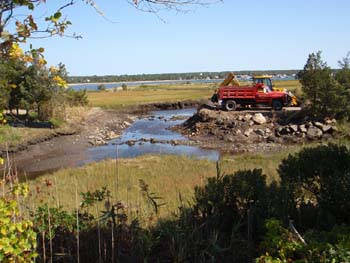
Salt Marsh tidal restriction MT06 (Mattapoisett 06) during removal in 2008.
Can you find the before picture in the Google Earth map database?
You need the most recent update of Google Earth to view the photographs.
Basics about Salt Marsh Restoration
Salt marsh grasses must be periodically tidally inundated, but cannot be permanently submerged. Consequently, the upper limit of the high marsh (principally the species Spartina patens) is found in Buzzards Bay up to one foot above Mean Higher High Water (MHHW). The lower marsh (principally the species Spartina alterniflora) typically grows down to somewhat above Mean Low Water (MLW). If the salt marsh is restricted by an undersized culvert, or an elevated culvert, the elevations and extent of salt marsh may be reduced, and invasive or brackish water species may replace the Spartina. These restricted marshes may also contain nuisance algal growth or odors from period anoxic conditions.
To alleviate these conditions, larger culverts, or culverts at different elevations may be installed. Below are two typical tidal restriction conditions faced. Engineers will select replacement culverts depending upon culvert elevations, culvert diameters, culvert lengths, and area and volume of water needed in the restricted marsh. The larger and deeper the culvert, the more closely will the tidal range and salt marsh elevations match fringing bay marsh elevations.
Interactive Atlas Map
![]() This map has information and locations about each tidal restriction. Click on the dots to identify the site. This file requires Google Earth installed on your computer (a free program).
This map has information and locations about each tidal restriction. Click on the dots to identify the site. This file requires Google Earth installed on your computer (a free program).
2014 tidal restrictions status map for Google Earth
If a site near you does not include a photograph, please email us a picture so we can include it in the database. Please also report any errors you find. You need the most recent update of Google Earth to view the photographs.
Allens Pond Restoration
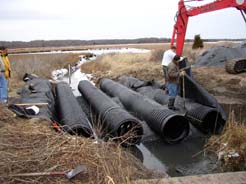
In late 2003, the Buzzards Bay NEP prepared the local permit application (a Notice of Intent) for a salt marsh restoration at Allens Pond, site DA11 in the Atlas. The project was a partnership between the USDA Natural Resource Conservation Service, and Mass Audubon, the property owner. The restoration is profiled on this USDA webpage
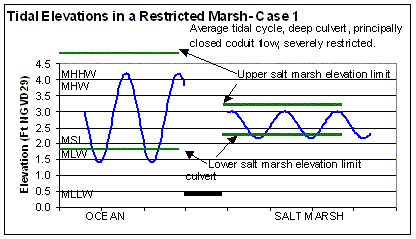
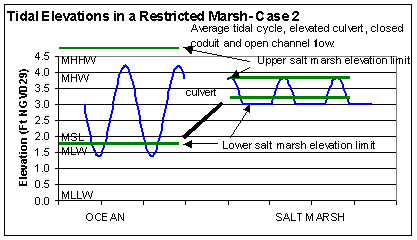
Salt Marsh Atlas Database Updated
In the late 1990s we began working with public and private property owners to restore tidally restricted salt marshes. We also began developing a data base of tidally restricted wetlands. In 2000 we drafted an atlas of tidally restricted wetlands, but it was not finalized until 2002. In 2009 we updated salt marsh atlas database to include the current status of sites, and we updated our Google Earth software kml map file (see link at the bottom), which now has a lot more of the original 2002 atlas information. We have even now included links to photos for many of the sites. If a site near you does not include a photograph, please email us a picture so we can include it in the database. Please also report any errors you find.
BB Salt Marsh Atlas Downloads
June 2002 final Atlas data table (Appendix A, a pdf file)
Complete Report, 300 dpi resolution (46 MB file)
Sections 2-4 and the complete report are very large. If you attempt to open them in your browser, your browser may give you a timeout error. Instead, right click on the link and download the file to your computer, then open it.
See also our 2014 Marsh Atlas Update
Other Benefits of Restoring Tidal Flushing
Restoring tidal flushing to impaired salt marshes has other benefits besides environmental ones. Tidal restrictions trap water after major storms, causing prolonged flooding of homes and properties. One of the most conspicuous examples of this in the Buzzards Bay watershed occurs at a tidal restriction in Woods Hole.
Water over-topped this damaged seawall (left, restriction FA02) facing Buzzards Bay on Gardner Road in Woods Hole during a Nor’easter in April 2007. This seawall was damaged also in another storm in 2006. The old seawall has blocked for decades the natural tidal flow to a wetlands crossing though Woods Hole Village to Eel Pond (FA40). Because there is no culvert under the seawall (as there should be), there is no place for the flood waters to go. Consequently during elevated tides like this nor’easter, water remains trapped in resident’s back yards. After this storm, 1 to 2 feet of standing water remained in the yards of the Gardner St. residents for more than a week. The BBNEP has been encouraging the town and the property owners to address this problem to no avail. Click on the photos to enlarge them.
Related Correspondence & Brochures
BBP review of a technical report on a proposed culvert replacement to improve tidal flow to a salt marsh at Little Island in West Falmouth (7/23/03 pdf file)
Our review illustrates what kinds of complex issues can surround a tidal restriction salt marsh restoration project, and a common sense approach for evaluating proposed designs.
Restoration Brochure Sent to Land Owners(120 kb pdf)
Hammett Cove Salt Marsh Restoration Brochure(Marion, MA, 120 kb pdf)
Winsegansett Salt Marsh Restoration Brochure (Fairhaven, MA, 213 kb pdf)
Buzzards Bay Project National Estuary Program. 2002. Atlas of Tidally Restricted Salt Marshes in the Buzzards Bay Watershed Massachusetts. July 2002. 31 pages.
